A long time ago, before a giant mouse bought the rights to one of the biggest franchises in existence, there was a thing called the Star Wars Expanded Universe or EU. At its peak, it included hundreds of books, thousands of comics, a dozen video games, and some other stuff. It was rich, it was big, it was beautiful. As of now, it has been downgraded from canon to being…old and sad (though not without value). This is Star Wars Legends.
Now, let’s talk about the books.
For a long time, I considered myself a Star Wars fan. I was probably a fanboy to be honest. The thing is, I wouldn’t have been so attached to the Star Wars Universe if it wasn’t for the books. They allowed me to be immersed in that world past the movies. They told different stories and used different characters and structures to kept Star Wars alive for me. There were bad apples of course, but also golden ones.
Nowadays, it doesn’t matter that much anymore. Star Wars has been rebooted and I suppose some would like to stay in that universe a while longer. Maybe the stories of the new Extended Canon aren’t enough for you. Or maybe you’re just curious about what was done before but you don’t know where to start. If so, this guide is for you. I’m the only writer of this piece so, of course, everything that follows should be considered the one and only definitive truth. If I fail to mention something, it’s because it’s wasn’t worthy to begin with. Or, you could complete my work in the comments by sharing the stories you’ve read and liked.
For each story, I’ll try to explain why they are interesting even today, with minimal spoilers. If I do spoil some elements, it’ll be specified before, so you can skip the paragraph. Here we go.
The Thrawn Trilogy by Timothy Zahn
I’m opening with the big guns. If you had any friend vaguely interested in Star Wars Legends and the books, you have heard of this series before. It’s basically everyone’s go-to when it comes to recommendations.
The Thrawn series is comprised of three books, all by the same writer: Heir to the Empire, Dark Force Rising, and The Last Command. The story itself happens 9 years after Episode IV and 5 years after Episode VI. After the Empire was seemingly defeated, the Rebellion managed to take back the capital world of Coruscant and establish a New Republic. The Empire isn’t entirely destroyed though, and the heroes of the original trilogy (OT) have to face a new enemy in Thrawn. He’s one of the remaining Grand Admirals and a tactical genius that attempts to bring the Empire back to full force.
Doesn’t sound much like this, but this story was basically presented to me as the real “Third trilogy” when I started asking about books. It has a huge cult following, and I’m not going to tell you a lot more about it because it’s best to enter unspoiled. The Thrawn trilogy is a solid story and is representative of the best of the books that told stories after the OT. Timothy Zahn is an excellent writer who doesn’t just describe events. He takes his time to develop his characters as best as he can.
If you haven’t even considered it yet, you probably should. This series is not only a good start for the EU post-OT but also a good story that follows our favorite heroes after their battle against Evil.
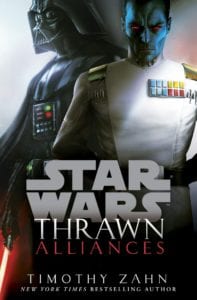
Light Spoiler section. It’s easy to say how important these books were for what will become the Expanded Universe. They introduced some of the most famous concept and characters. The name Coruscant for the capital-world actually appeared first in these books. The most famous character introduced is probably Mara Jade, a badass warrior trained and used by the Emperor for his dirty deeds. One character I find particularly interesting is Gilad Pellaeon, a soldier from the Empire and a POV character. He gives us a chance to read into the mind of an imperial who wasn’t the incarnation of evil.
And then, of course, there’s Thrawn himself, a character so loved that they brought him back into the new canon. At the first read, he’s a fascinating villain and it’s no surprise that this trilogy bears his name. He can seem a little overpowered upon further re-reads, but I’d argue though that Grand Admiral Thrawn was the kind of villain Star Wars needed after the death of the Emperor. Not the devil incarnate that Palpatine was, but a military genius, a perfect representation of the Empire. A villain who inspires loyalty not by fear but respect. Unfortunately, his character got a little overused once he became popular.
Thrawn and Gilad actually work together to give us a better idea of how the Empire works and what it can represents for the average soldier. Or rather the average officer. At some point in the Legends universe, some authors pushed this representation a bit too far. The Empire became almost a victim, but in these early books, that wasn’t the case.
All in all, the story of the Thrawn trilogy doesn’t have the grandiose nature of the movies, but they are a good follow-up to them. Especially Thrawn and company as villain one would imagine to exist after the Empire collapses.
The Bane Trilogy by Drew Karpyshyn
This is a more recent series and completely different in conception than Thrawn. Drew Karpyshyn tells the story of Darth Bane, the Sith that created the order we know from the movies, including the infamous “Rule of Two” stating that only two Sith should exist at the same time: Master and Apprentice. Thus, it takes place about 1000 years before the movies.
The trilogy consists of Path of Destruction, Rule of Two, and Dynasty of Evil. Drew Karpyshyn is a bit all-or-nothing when it comes to character, making them either interesting trope busters or the incarnation of a cliché. But that’s what makes the story fun and interesting, oddly enough. The first book particularly paints a delightful subversion of the Hero’s journey through Bane himself (when he isn’t even called Bane yet.) It also uses tropes and ideas that were common in the Young Adult books of the early 2000s and applies them almost to the letter. But they’re applied to a Dark Lord of the Sith, so they get points for the weirdness that ensue.
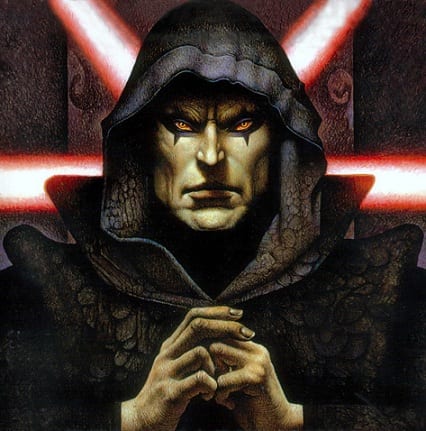
The rest of the story is a lot more standard, for Star Wars Legends at least. Not bad, by any means, but the real meat of Bane’s story is over by the end of Path of Destruction. It is very good meat though. Bane is a surprisingly fun character to follow and he never get over shadowed by a supporting character.
It’s also, as far as I can tell, still possible to consider the story semi-canonical. The new canon doesn’t provide more information on Bane than what we already know. He’s the creator of the Rule of Two, which is still canonical. This means that, if you’re the kind of person who isn’t interested in any story that isn’t entirely canonical, you might be able to trick your brain into thinking this one is.
The Republic Commando Series by Karen Traviss
We’ve done post-OT and pre-Everything, let’s now go to everyone’s favorite part of the Star Wars timeline: The Clone Wars. This period of the Star Wars canon has been covered to death. The three years that separates Episode II from Episode III are probably the busiest in the history of Star Wars considering the number of books, comics, games, etc. that takes place in it. It can be a little difficult to choose a favorite among them.
This series has the advantage of covering almost the entirety of this period, from the start of the Clone Wars to Order 66. There are 4 books, 5 if you count Imperial Commando: the 501st, although the last one doesn’t really cover the Clone Wars era. As their name indicates, those books don’t follow our traditional Jedi heroes, but instead focus on Clone Commandos. Bred to be elites among the clone army, they are only sent on the most dangerous operations.
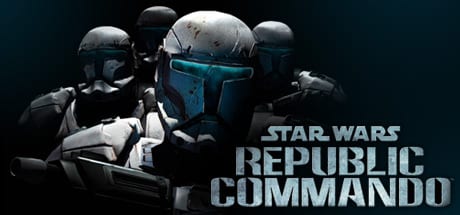
The first of the series, Hard Contact, is a simple war story with very little background information. It’s effective and interesting in the way we follow several characters, from our protagonist clones to their enemies, without forgetting a Jedi Padawan that happened to be there. If you’re looking for a fine infiltration story in the universe of Star Wars, this is your book. The later additions to the series were more concerned with the implications of the war, the clone army, and what the Republic truly intended for them.
The story is particularly interesting to me in how it treats the Jedi. I could even say Karen Traviss suffers from an extremely anti-Jedi bias. The books are almost a manifesto for the Mandalorian culture. She depicts its honor-bounds traditions in the highest of lights. At the very least, seeing the Jedi from this point of view is refreshing. It explores the many implications of having a clone army for the Republic, which fills some of the holes left by the prequel trilogy. However, Traviss’ obsession with the Mandalorian culture can be an issue for readers, so be warned.
Of course, none of this is canon anymore. Especially the whole Mandalorian culture bit, which actually seems to have been a reason for the break up between Traviss and Lucasarts at the time.
Also, there is also a game following some of the characters and it’s still quite fun to play, if you want to try out Star Wars games alongside reading the Legends books.
The New Jedi Order by various authors
Like, very various: R. A. Salvatore, Michael AL. Stackpole, James Luceno, Kathy Tyers, Greg Keyes, Troy Denning, Elaine Cunningham, Aaron Allston, Matthew Stover, Walter Jon Williams, Sean Williams, and Shane Dix.
This series is also one that simply had to be there. Not really because of its overall quality but because of its importance. It is simply the most massive work ever published when it comes to Star Wars. 19 books from start to finish, covering a total of 4 years with hundreds of characters, events, plot twists, and more. Considering that and its effect on the Star Wars canon of the time, I just have to talk about it.
Let’s start with the story. A race of extragalactic beings called the Yuuzhan Vong launch an attack on the whole galaxy as we know it, 25 years after A New Hope. Many of the original heroes return for a fight: Luke, Han and Leia, Chewbacca, and more, including most of the characters introduced in previous novels. Han and Leia’s children (yes, there are more than one) start to take an important role in the galactic affairs. The New Republic has to face an enemy more powerful than ever. The entire galaxy suffers immense loss and pretty much every little faction must join forces to even have a chance of defeating the invaders.
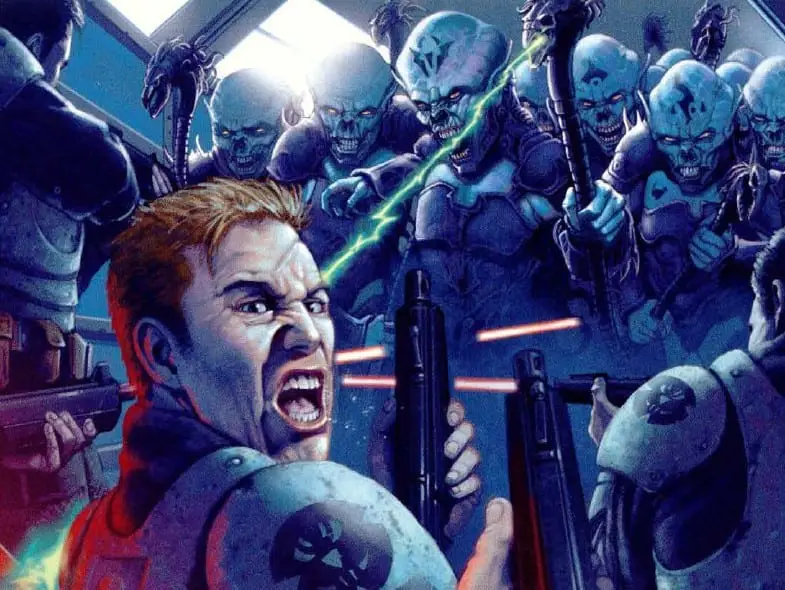
Honestly, there is not a lot more to the story than this. It’s an epic tale of conflict against an invading force. It also manages to be even more black and white than literal space Nazis against the Resistance. It has its flaws, lots of them, but its importance in Star Wars Legends is too great to ignore its existence. The events of The New Jedi Order are referenced in many of the later books and even some stories that happen before it in the timeline (back to this in a second), so you should at least read the Wookipedia page on this war.
Very light spoiler on Legends as a whole: the most interesting part of this story is that it blows up everything else in the canon. When it comes to the story of a galaxy far far away, there aren’t a lot of events that will top an invasion by an extragalactic race. Because of that, many writers of the Legends canon took it upon themselves to build up that threat in the years before the start of the conflict.
Noble idea with terrible implication. In many books, it is now implied that Palpatine knew what was coming. His over-militarization of the Empire, to the point of creating the Death Star, wasn’t just for the destruction of the Rebels, it was a way to prepare the galaxy for the war to come. Of course, it also implies that the Rebels doomed the galaxy to suffer the terrible losses it endured during the conflict, since they destroy most of the Empire’s super-weapons. So… yeah. Terrible implications.
So many books and comics reference the Yuuzhan Vong before and after the conflict that it has become a must-read, or a must-know, of the EU. It’s understandable if 19 books are a bit too much for you, but again there is a Wookieepedia page for this.
Death Star by Michael Reaves & Steve Perry
In my quest to present books from all over the timeline, I present to you Death Star. It takes place between the first two film trilogies and focuses on the super-weapon so important to Star Wars it gets a reference in almost every movie. You can already guess that Rogue One makes this entire thing a lot less canon, mainly because the men in charge are different and the first attempts to build the Death Star are different.
This book belongs to a category I like to call “simple stories.” There are actually many books and stories in Star Wars Legends that fit in there. They are not life-changing events for the galaxy, not complex political networks navigated by our characters, and usually not difficult quests taken on by Jedi or Sith. They are just stories of people in the gigantic galaxy that is the Star Wars universe. This one happens to involve characters close to the Death Star, including a surgeon working for the Empire, some of the prisoners used as a workforce to build the super weapon, and even some of the people who “pressed the button.” (The kinds of character you like to know if you want to gloat over your knowledge of Star Wars trivia at a dinner with your nerd friends.)
It may not sound like much and, to be fair, it’s not. It’s a competent, nice, simple story about some characters you don’t see often in Star Wars. You can read it as a singular, independant installment. You don’t need any previous knowledge of the hundreds of books that came before. Some characters appeared before, but you could be unaware of that fact and it wouldn’t change a thing. So, if you want to try Legends but its size is too overwhelming, this is a very comfortable read.
Also, Death Star. Apparently, a must-have in Star Wars nowadays.
The Legacy of the Force Series by Aaron Allston, Karen Traviss, and Troy Denning
After the grand storyline that was The New Jedi Order and its relative success, Legends became less shy of stories spawning more than 3 books. Legacy of the Force is one of the results. Taking place more than 40 years after A New Hope, it tells the story of our heroes becoming old, having to deal with a new Sith Lord, and passing the torch to a new generation.
Kind of.
It’s hard to talk in detail about this story without spoiling anything, but at the time it came out, it felt like a great culmination and conclusion to the Legends universe following the movies. The age of our heroes is finally addressed. It comes back to some of the themes of both the OT and the PT. Yet it still felt like a deeply personal story, a lot more than The New Jedi Order did. All of that is actually great, and that’s why I feel like I should recommend it. That and you may find some similarities with the sequel trilogy. The treatment is different, but the point is similar.
However, it has some issues, mainly the fact that it has three authors with vastly different opinions on the Star Wars universe. And it shows. The gap in style and ideas between the books can be quite jarring. I wouldn’t say one is better than the other, but each style will speak to a different kind of reader.
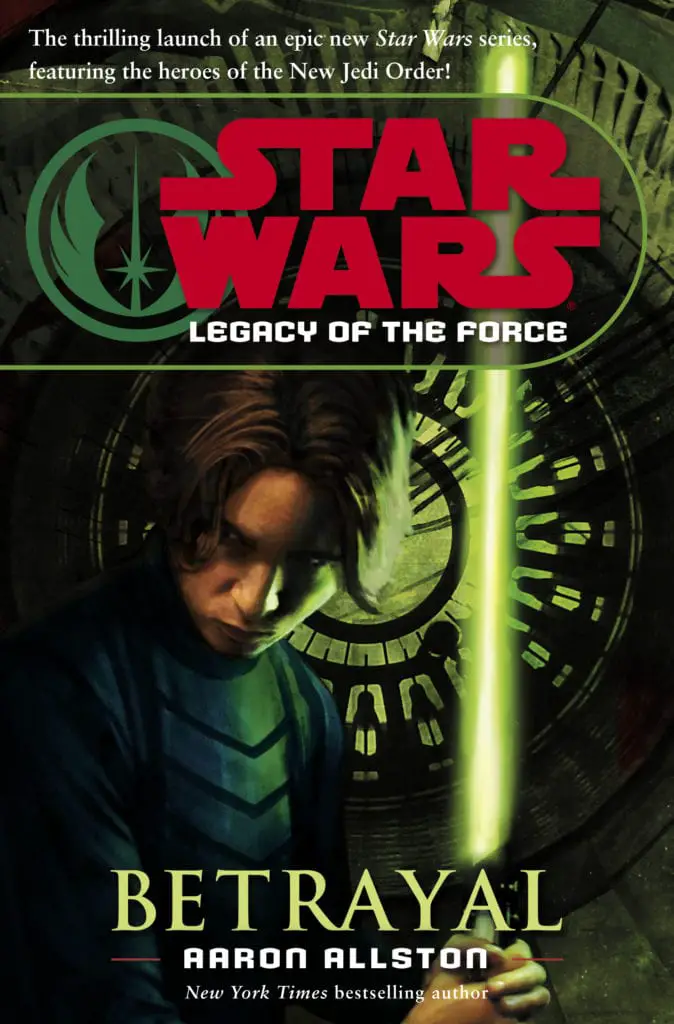
And now, a light spoiler section because this story needs it.
The Legacy of the Force is about the fall to the Dark Side of one of Leia and Han’s children. It has nothing to do with Kylo Ren, but that’s what makes the story so interesting. In a lot of way, it feels like a response to the PT. The Galaxy faces a new Civil War, a conflict the Jedi want nothing to do with. Jacen Solo, Leia’s son, has slowly drifted apart from the order in search of his own path. He strongly feels like he should do something, and that’s his story.
It’s written after the PT was completed, and Vador’s full story comes into light, serving as a comparison point for characters, including Jacen himself. That’s the fun part of it all. Jacen knows about Anakin’s fall and still thinks he’s not like that. He’s a full-grown adult, with a child, a man who knows about the Force a lot more than anyone in the galaxy, since he studied it in many different cultures. He doesn’t “fall” into the Dark Side, he dips a foot in it and control his slow descent. Or so he thinks.
Having Darth Caedus (Jacen Solo’s Sith name) as a POV character is one of the major perks of this story, but it does have issues. Mainly, his counterpart on the hero side, his twin, Jaina Solo, doesn’t get as much material as she deserves. She does, however, stay a badass character throughout the whole story and the confrontations between the two are memorable and powerful.
Although it sometimes feels like writers trying to do the PT right (which you may like, I guess), these books are a worthwhile read on their own merits.
Medstar by Michael Reaves & Steve Perry
The last on the list, Medstar is a duology telling the story of a war zone during the Clone Wars. You might notice the writers also wrote Death Star and it’s in the same genre. Except, it’s even more removed from the history of our galaxy.
Medstar has nothing to do with the global conflict, the Dark Side, the Light Side, the Jedi, the Sith, the Mandalorians. All of that brings nothing to these books. These tell the stories of a bunch of nobodies lost on a planet nobody would care about if it wasn’t for the war. Most of the characters are doctors and surgeons, but you will encounter a Jedi, a few soldiers, and a lot of weirdos, including criminals and corrupt politicians.
There is no grand scheme here, just people trying to survive, to strive, to live, to love, and to learn. Learning is the main theme of these books—improving and growing. Our characters face the absurdity of a war they mostly don’t care about. With a conflict that destroys lives and minds, they need to adapt.
Among other themes, you’ll find classic sci-fi questions. What’s the place for clones in society? What about droids? When their A.I. is that good, are they people? And, most importantly, can they get drunk?
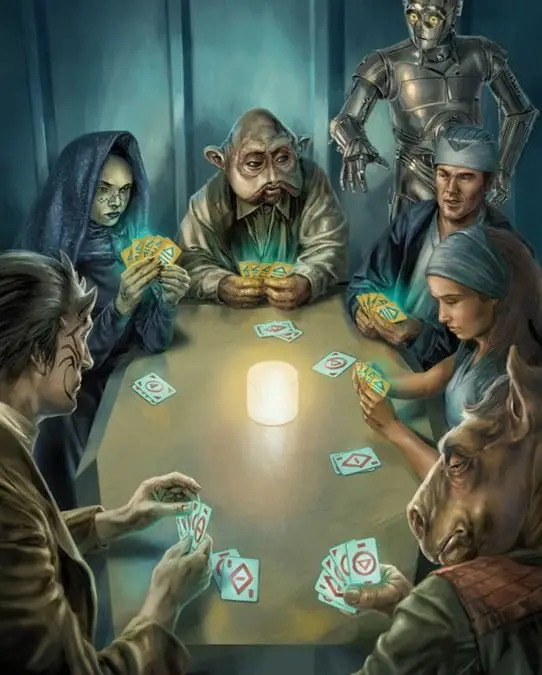
Medstar were some of the first books I discovered when exploring Legends. They are the reason I actually got so involved with the EU. They are a perfect demonstration of the spectrum of stories you can tell in the setting of Star Wars. There is nothing grandiose about them, nothing spectacular. You’re following people being people. And sometimes, that’s more than enough.
I’ve re-read them recently and I will say, Medstar is a little jewel of a story. It’s simple, but it has a heart and a soul. I’d like to believe that it represents the Legends universe more than galactic conflicts and epic confrontations. So, if you feel like it, please give it a try.
Honorable mentions (i.e., a bunch of stories I haven’t read but heard were great)
Don’t judge me. Nobody has read the entirety of the Legends books, but I’m lucky enough to know people, so here is a little list of books I can’t talk as much about since I don’t actually know them.
The X-Wing saga: A series of books that follow characters different from our usual Jedi and Sith. The quality varies greatly between books, but they establish some of the most important characters in canon. Because of that, you’ll see it often referenced.
Jedi Academy: Young Adult novels that introduce and develop a great number of characters, especially the new generation of Jedi, which are almost always important in subsequent books and stories. This series improves the read of many stories that come after it in the timeline. All the characters are different, fun and interesting to follow.
Fate of the Jedi: The last great series of books before the end of the Legends saga. They’re almost a conclusion, though the Legends universe does continue with a few books and some comics happening a hundred years later. The story still follows our OT heroes, Luke among them even more prominent than in Legacy of the Force. Considering its place in canon, it has to be an interesting read, I just haven’t gathered the courage to read it yet.
—
There is probably a ton I forgot or couldn’t find a place for. If you’re familiar with the Legends universe, you know how dense and intricate it can be. You also know how its quality can vary. I hope this article gives people not yet familiar with it a starting point or two. If you decide to start, you’ll soon find what you like the most and be able to make your own list. I’m sure you’ll be able to talk about it for hours, just like I can.
Bunch of nerds.

